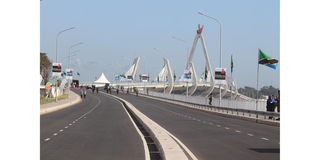Why the Tanzanite Bridge was built

Tanzanite Bridge. PHOTO | SUNDAY GEORGE
What you need to know:
- The government said that the construction and commissioning of the 1.03-kilometre Tanzania Bridge is a significant step in efforts to ease traffic congestion in Dar es Salaam
Dar es Salaam. The government said the construction of the 1.03-kilometre Tanzania Bridge is significant in efforts to address the challenge of traffic congestion in Dar es Salaam.
The $123.032-million project (about Sh243 billion) also would play a role in creating new tourism attractions and reducing road accidents in the sea-side commercial capital.
Works, Transport and Communications minister Makame Mbarawa made the remarks yesterday during the inauguration of the Tanzanite Bridge that officially became open on February 1, 2022.
He said the chronic traffic congestion forced the government to come up with plans that included construction of roads and bridges in order to reduce, if not eliminate, the challenge.
“The plans that were included in the CCM election manifestos 2015 and 2020 have significantly reduced the challenge. For instance, our study shows that an average of 17,726 to 19,764 vehicles pass on the new bridge daily on weekdays,” he said.
“Linking the beaches of Sea View to Coco, the bridge will also serve as a tourist attraction and inclusion of pedestrian roads will greatly reduce road accidents in the city,” he added.
He said the road will promote the country’s economy through trade facilitation and stimulation, hinting that the Kikwete Bridge along the Malagarasi River was another project jointly executed by Tanzania and the Republic of South Korea.
Prof Mbarawa infrastructure development projects spent billions of taxpayers’ money, noting that Parliament enacted the law allowing the Roads Fund to spend about 90 percent for rehabilitations.
“This has increased the government’s ability to conserve infrastructure, the obligation that will be maintained by the ministry,” he said, pledging that his docket will continue following up implementation of projects to ensure they are completed on time and agreed quality.
Speaking before launching the project, President Samia Suluhu Hassan said Tanzanite Bridge has been constructed through a $123.032-million soft loan secured from Exim Bank of South Korea through the country’s Economic Development Cooperation Fund (EDCF) and $4.233 million from the Tanzania government.
“These efforts aimed at improving transport in Dar es Salaam. Efforts to execute other Bus Rapid Transport (BRT) phases were underway,” she said.
She named the phases as those involving connecting the city centRe with Gongolamboto; city centre to Tegeta and Ubungo to the Ports through the Nelson Mandela Expressway.
Others are Kigogo to Segerea via Tabata Dampo and Morocco to Kawe and Lugalo, observing that completion of the projects would significantly address the traffic congestion challenges in the city.
“Economic and trade activities will be stimulated by reducing time spent on roads, reducing fuel consumption and family disputes due to late arrivals from workplaces due to traffic jams,” she added.
President Hassan affirmed that measures being taken to improve Dar es Salaam’s outlook and impression were also being taken in other cities including Dodoma where a ring road project is being implemented to reduce congestions in the fast growing city.
Regarding billions of shillings spent on infrastructure projects, she asked citizens to heighten maintance measures and rehabilitation by the ministry.
Earlier, Tanzania National Roads Agency (Tanroads) chief executive officer Rogatus Mativila said feasibility study and detailed engineering design conducted in 2017 established that an average of 52,000 vehicles were daily passing on the Selander Bridge.
“The 2008 prepared Dar es Salaam Transport Policy Development Master Plan prepared by Japan International Cooperation Agency (Jica) in collaboration with Dar es Salaam City Council (DCC) proposed the construction of this new road to reduce congestion, which is the origin of the Tanzanite Bridge,” he said.
Outlining the bridge specifications, he said it was 1,030-metres long and 20.5 metres wide; consisted of four lanes; two each side and two pedestrian roads, one on each side.
He said the bridge also has 5.2 kilometres with four lane approach roads constructed at the tarmac level and 20.5 metres wide.
He said the project created 960 jobs; 886 equivalent to 92 percent to Tanzanians and 74 others equals to eight percent to foreigners.
According to him, the project whose construction contract was inked in 2018 was concluded on December 27, last year and was opened on February 1, 2022, noting that it will remain under the contractor’s observation until December 28, 2024.
Republic of Korea ambassador to Tanzania Kim Sun Pyo said the project will remain a symbol of success and cooperation between the two countries.
Deputy National Assembly Speaker Mussa Azan said apart from the 190 trillion litres Kidunda Water Project, Dar es Salaam benefited from implementation of different development projects.
In his speech, the Dar es Salaam Regional Commissioner, Mr Amos Makalla named other projects as the Sh200-billion sewerage project and the Sh200 billion Jangwani Bridge aimed at controlling flood.
Others are the Sh234-billion BRT project and the Sh219 billion Kimara-Kibaha highway.




